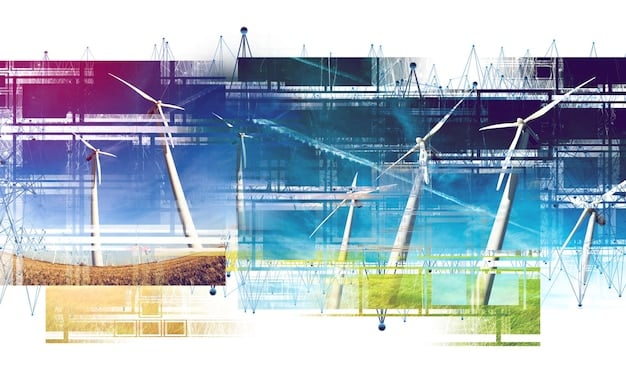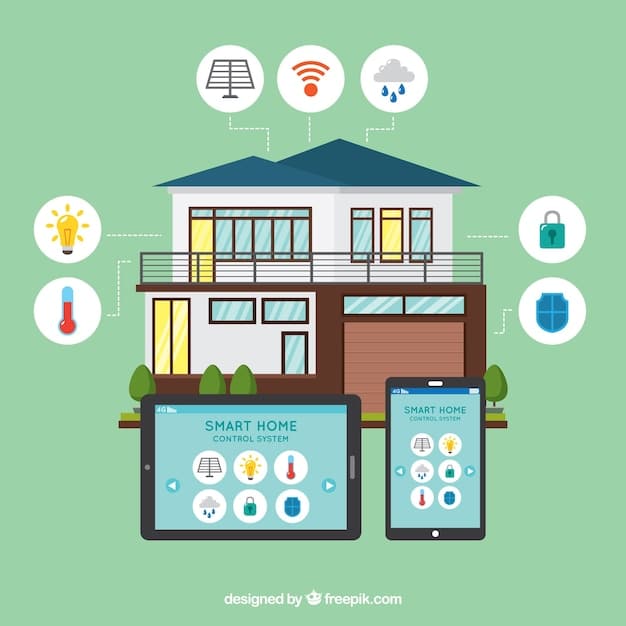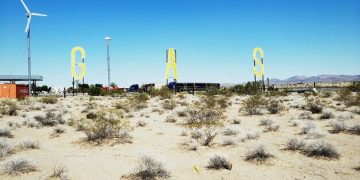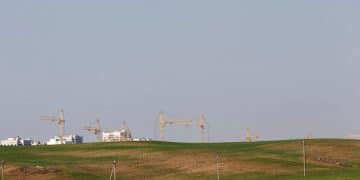Renewable Energy Surge: Impact on US Grid Stability by 2025

The projected 15% increase in US renewable energy capacity by 2025 poses both opportunities and challenges for grid stability, requiring advancements in energy storage, grid modernization, and smart grid technologies to manage intermittency and ensure a reliable power supply.
As the United States aims for a greener future, a significant increase in renewable energy capacity is anticipated by 2025. But how will the projected 15% increase in US renewable energy capacity by 2025 impact grid stability? This article delves into the potential effects, challenges, and solutions associated with integrating more renewable energy sources into the nation’s power grid.
Understanding the Renewable Energy Boom in the US
The United States is witnessing a rapid expansion in renewable energy, driven by environmental concerns, economic incentives, and technological advancements. This surge in renewable energy capacity, particularly from solar and wind sources, is set to reshape the nation’s energy landscape. Understanding the factors driving this boom is crucial to assessing its impact on grid stability.
Key Drivers of Renewable Energy Growth
Several factors are contributing to the increasing adoption of renewable energy in the US. These include:
- Policy Support: Government policies, such as tax credits, renewable energy standards, and carbon pricing mechanisms, incentivize the development and deployment of renewable energy projects.
- Falling Costs: The cost of renewable energy technologies, especially solar and wind, has plummeted in recent years, making them increasingly competitive with traditional fossil fuels.
- Environmental Concerns: Growing awareness of climate change and air pollution is driving demand for cleaner energy sources, pushing utilities and consumers toward renewables.
- Technological Advancements: Innovations in energy storage, grid management, and renewable energy technologies are improving the reliability and efficiency of renewable energy systems.
The convergence of these factors is creating a favorable environment for renewable energy growth, positioning the US as a global leader in the transition to a low-carbon economy.
In conclusion, the renewable energy boom in the US is fueled by a combination of policy support, falling costs, environmental concerns, and technological advancements, paving the way for a cleaner and more sustainable energy future.
The Challenge of Intermittency
One of the primary challenges associated with integrating renewable energy into the grid is the intermittency of solar and wind power. Unlike traditional fossil fuel-based power plants, renewable energy sources are dependent on weather conditions, leading to fluctuations in energy production. Managing this intermittency is critical for maintaining grid stability.
Understanding Intermittency
Intermittency refers to the variable and unpredictable nature of renewable energy sources. Solar power is only available during daylight hours, and wind power depends on wind speed, both of which can fluctuate significantly. This variability can create challenges for grid operators, who must ensure a constant balance between supply and demand.

Strategies for Managing Intermittency
Several strategies can be employed to mitigate the impact of intermittency on grid stability. These include:
- Energy Storage: Deploying energy storage systems, such as batteries and pumped hydro storage, can help smooth out fluctuations in renewable energy generation and provide a reliable power supply.
- Grid Diversification: Connecting geographically diverse renewable energy projects can reduce the impact of localized weather events on the overall energy supply.
- Demand Response: Implementing demand response programs can shift energy demand to match renewable energy availability, helping to balance supply and demand.
- Improved Forecasting: Developing more accurate forecasting models can help grid operators anticipate fluctuations in renewable energy generation and adjust grid operations accordingly.
Implementing these strategies is essential for ensuring that renewable energy can be reliably integrated into the grid, without compromising grid stability.
In summary, intermittency is a key challenge in integrating renewable energy, but various strategies, including energy storage, grid diversification, demand response, and improved forecasting, can help mitigate its impact and ensure grid stability.
The Role of Energy Storage
Energy storage is playing an increasingly important role in ensuring grid stability as the share of renewable energy grows. Energy storage systems can store excess energy generated during periods of high renewable energy production and release it during periods of low production, helping to balance supply and demand and mitigate intermittency.
Types of Energy Storage Technologies
Various energy storage technologies are available, each with its own advantages and disadvantages. These include:
- Lithium-ion Batteries: Lithium-ion batteries are the most widely used energy storage technology, offering high energy density, fast response times, and declining costs.
- Pumped Hydro Storage: Pumped hydro storage involves pumping water uphill to a reservoir during periods of low demand and releasing it downhill through turbines to generate electricity during periods of high demand.
- Flow Batteries: Flow batteries store energy in liquid electrolytes, offering long discharge durations, high scalability, and potential for long-term energy storage.
- Compressed Air Energy Storage (CAES): CAES involves compressing air and storing it underground or in tanks, then releasing the compressed air to drive turbines and generate electricity.
Benefits of Energy Storage for Grid Stability
Energy storage systems can provide several benefits for grid stability, including:
- Frequency Regulation: Energy storage can quickly respond to changes in grid frequency, helping to maintain grid stability and prevent blackouts.
- Voltage Support: Energy storage can provide voltage support to the grid, improving power quality and reducing the risk of voltage sags and swells.
- Peak Shaving: Energy storage can reduce peak demand on the grid, lowering electricity costs and reducing the need for expensive infrastructure upgrades.
As renewable energy deployment continues to grow, energy storage will become increasingly critical for ensuring grid stability and reliability.
In conclusion, energy storage plays a crucial role in mitigating intermittency challenges and ensuring grid stability, with various technologies offering unique benefits and capabilities, making it an essential component of the future energy landscape.
Modernizing the Grid Infrastructure
Modernizing the grid infrastructure is essential for accommodating the increasing share of renewable energy. The existing grid was designed for a centralized system with large, fossil fuel-based power plants. Integrating distributed renewable energy sources requires upgrading and adapting the grid to handle bidirectional power flows and variable energy inputs.
Key Aspects of Grid Modernization
Grid modernization involves upgrading various components of the grid infrastructure, including:
- Smart Grids: Implementing smart grid technologies, such as smart meters, sensors, and advanced communication systems, can improve grid monitoring, control, and automation.
- Transmission Upgrades: Upgrading transmission lines and substations can increase the capacity of the grid to transport renewable energy from remote generation sites to load centers.
- Distribution Automation: Implementing distribution automation technologies can improve the efficiency and reliability of the distribution grid, enabling better integration of distributed renewable energy sources.
Benefits of Grid Modernization
Grid modernization can provide several benefits, including:
- Improved Reliability: Modernizing the grid can reduce the frequency and duration of power outages, improving grid reliability and resilience.
- Increased Efficiency: Grid modernization can reduce energy losses in the transmission and distribution system, improving energy efficiency and lowering costs.
- Enhanced Flexibility: A modernized grid can better accommodate variable renewable energy sources, improving grid flexibility and enabling a more dynamic energy system.
The modernization of the grid is a complex and multifaceted undertaking, requiring significant investments and collaboration among various stakeholders.
In summary, modernizing the grid infrastructure is crucial for integrating renewable energy sources, improving reliability, increasing efficiency, and enhancing flexibility, paving the way for a more sustainable and resilient energy system.

The Impact on Electricity Markets and Pricing
The increasing share of renewable energy is also impacting electricity markets and pricing. Renewable energy sources often have lower operating costs than traditional fossil fuel-based power plants, which can drive down wholesale electricity prices. This can create challenges for traditional power plants, but also benefits consumers through lower electricity bills.
Market Dynamics with Renewable Energy
The integration of renewable energy is changing the dynamics of electricity markets in several ways:
- Merit Order Effect: Renewable energy sources are often dispatched first in the electricity market due to their low operating costs, displacing more expensive fossil fuel-based power plants.
- Price Volatility: The intermittency of renewable energy can lead to greater price volatility in the electricity market, with prices fluctuating based on weather conditions and renewable energy availability.
- Capacity Markets: Capacity markets are being implemented to ensure that there is sufficient generation capacity to meet peak demand, even during periods of low renewable energy production.
Impact on Consumers
The increasing share of renewable energy can have several impacts on consumers, including:
- Lower Electricity Bills: Renewable energy can drive down wholesale electricity prices, leading to lower electricity bills for consumers.
- Choice and Control: Consumers are increasingly able to choose renewable energy options, such as purchasing renewable energy from their utility or installing rooftop solar panels.
- Energy Independence: Renewable energy can reduce dependence on fossil fuels, improving energy security and independence.
As renewable energy deployment continues to grow, it is important to carefully manage the impacts on electricity markets and pricing to ensure a fair and sustainable energy system.
In conclusion, the shift towards renewable energy is transforming electricity markets and pricing, influencing dispatch order, price volatility, and the design of capacity markets, ultimately affecting consumers through lower electricity costs, increased choice, and enhanced energy independence.
Policies and Regulations Driving Renewable Energy Integration
Government policies and regulations play a crucial role in driving the integration of renewable energy into the grid. These policies can provide incentives for renewable energy development, set targets for renewable energy deployment, and ensure that renewable energy is treated fairly in the electricity market.
Key Policies and Regulations
Several key policies and regulations are driving renewable energy integration in the US, including:
- Renewable Portfolio Standards (RPS): RPS policies require utilities to obtain a certain percentage of their electricity from renewable energy sources.
- Tax Credits: Federal and state tax credits provide financial incentives for renewable energy projects, reducing the cost of renewable energy development.
- Net Metering: Net metering policies allow consumers who generate their own electricity from renewable energy sources to sell excess electricity back to the grid.
- Interconnection Standards: Interconnection standards ensure that renewable energy projects can connect to the grid in a safe and reliable manner.
Impact on Renewable Energy Deployment
These policies and regulations have had a significant impact on renewable energy deployment in the US, driving investment in renewable energy projects and accelerating the transition to a low-carbon economy.
In summary, government policies and regulations are essential for driving renewable energy integration, providing vital incentives, setting deployment targets, and ensuring equitable treatment in the electricity market, significantly influencing the pace and scale of renewable energy adoption across the nation.
Future Outlook and Innovations
The future of renewable energy and grid stability looks promising, with ongoing innovations in energy storage, grid management, and renewable energy technologies. These innovations will help to further reduce the cost of renewable energy, improve its reliability, and enhance grid stability.
Several key trends and innovations are shaping the future of renewable energy and grid stability:
- Advanced Energy Storage: Development of advanced energy storage technologies, such as solid-state batteries and flow batteries, will provide longer duration and lower cost energy storage solutions.
- Artificial Intelligence (AI): AI and machine learning algorithms can be used to optimize grid operations, improve forecasting accuracy, and enhance grid resilience.
- Microgrids: Microgrids can provide localized energy solutions, improving grid reliability and enabling greater integration of distributed renewable energy sources.
As these innovations continue to develop, renewable energy will play an increasingly important role in the US energy system, contributing to a cleaner, more reliable, and more sustainable energy future.
In brief, the future of renewable energy and grid stability is bright, fueled by continuous innovation in energy storage, grid management, and advanced technologies, promising to reduce costs, enhance reliability, and build a more sustainable energy ecosystem.
| Key Point | Brief Description |
|---|---|
| ☀️ Intermittency Challenge | Renewable sources depend on weather, causing variability. |
| 🔋 Energy Storage | Batteries and other tech balance power supply. |
| ⚡ Grid Modernization | Smart grids improve reliability and efficiency. |
| 📈 Market Changes | Renewables lower costs, impacting pricing. |
Frequently Asked Questions
▼
Renewable energy comes from natural sources like sunlight, wind, and water, which are naturally replenished. Shifting to renewables reduces reliance on fossil fuels, minimizing carbon emissions and combating climate change, while also promoting sustainable energy systems.
▼
Intermittency refers to the variable nature of renewable sources, challenging the real-time balance of supply and demand on the grid. Fluctuations in solar and wind generation require sophisticated grid management strategies to prevent imbalances and ensure continuous power.
▼
Energy storage systems, such as batteries, store excess power from renewable sources for later use. This technology helps manage intermittency by providing a consistent energy supply, improving grid stability, and reducing the need for backup power from fossil fuels.
▼
Smart grids use advanced technologies to monitor, control, and automate energy distribution. These grids enhance efficiency, reduce outages, integrate renewable energy sources more effectively, and enable consumers to manage their energy usage, promoting overall grid stability and system resilience.
▼
Policies like Renewable Portfolio Standards (RPS), tax credits, and net metering encourage renewable energy development and adoption. RPS mandates a percentage of electricity from renewables, tax credits reduce project costs, and net metering allows consumers to sell excess energy back to the grid.
Conclusion
The projected 15% increase in US renewable energy capacity by 2025 presents both challenges and opportunities for grid stability. Addressing these challenges through advancements in energy storage, grid modernization, and supportive policies will be crucial for unlocking the full potential of renewable energy and creating a more sustainable and resilient energy future.





